Shan culture in Burma being ‘erased’
About the experience of organizing a conference and a post-conference tour in Summer 2005, and traveling to the conference and on the tour through the Golden Triangle region of Southeast Asia and Southwest China. Since then, I have been posting occasional news stories from the region.
When I traveled to Myanmar last year, we were repeated told (and had read) that the opium/heroin trade has been greatly reduced in recent years, with many of the former drug lords moving into tourism services (restaurants, etc), although the latter was primarily in reference to Thailand. Thus, I found this recent story from the BBC to be shocking. Opium/heroin is still produced and open used in Myanmar (especially in the Shan State, which we traveled in), and is closely related to the rapid spread of aids in Thailand and along the heroin routes extending into neighboring countries. The worse part of this is absolute silence on this topic by Myanmar's government, which exasperates the problem and suffering of the people of Myanmar. International aids groups are at a quandry on how to help the people of Myanmar, without supporting the government.
By Nelson Alcantara
Davao, Philippines (eTurboNews) -- The Myanmar government’s representative to the 25th gathering of the Association of South East Asian Nations (ASEAN) Tourism Forum was a no show at yesterday’s Myanmar’s scheduled press briefing.
Brigidair General Aye Myint Kyu, vice minister for Myanmar’s Ministry of Hotels and Tourism, was present at the ASEAN tourism minsters joint press briefing on Tuesday but did not show up for his country's scheduled NTO press conference. His presentation would have followed the presentations from Philippine Tourism Secretary Joseph Durano, who took the floor from 3:00pm to 4:00pm, and Singapore tourism officials, who took the 4:00pm to 5:00pm slot.
... Click this link for the full story:
In the middle of another busy semester, it now seems like my Goldent Triangle Trip was a long time ago. However, I will continue to add occasional postings here related to the Golden Triangle region of Southeast Asia.
We arrived back in Arizona on Sunday night. I am still jet lagged, though not too bad.
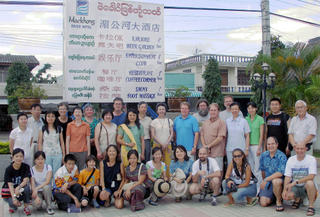
Our wake up call came a little after 5 am this morning, breakfast was a 5:30, and we left for the boat pier at about 6 am. Our boat is a new, high-speed jet boat that seats up to 66 people (6 across), which made it quite comfortable for our group of 31 plus luggage. We have two stewardesses who served us lunch and sold us snack in the air conditioned compartment. We were also able to go in the back and up on top to take photos when it was not raining.

Because we had four minivans here in Thailand, we were able to divide up the group to pursue different interests. One van with went to the Thai Queen Mother’s Flower Garden up in the hills, while the other vans went into Chaing Rai to access ATM machines, the Internet and shopping. After getting some cash I had about half an hour to quickly check my email and copy and paste my blog updates. We were then off for a full day of sightseeing.

When we were still in China, the Myanmar government was reluctant to give visas to the Americans in our group because we might criticize Myanmar after our trip. So far, we have not personally encountered anything that would cause us to criticize the government of Myanmar – until today. The plan was to leave Myanmar in the morning and have lunch in Thailand. However, there was a problem in leaving Myanmar. I had heard that they wanted us to either return to Jinghong or go to Yangon (Rangoon) o exit the country.

Two markets in one day, equal to about three hours of shopping. I think that for most people that was pretty good. We started the morning by going to Keng Tiong’s morning market. Fortunately, they had left the generator running all night, so we were able to shower with the lights on in the morning! Breakfast at the hotel involved the most elaborate and symmetrically laid out drinks and food that I have ever seen. Everyone who arrived early took a photo of it before we messed it up by taking our juice classes (guava or passion fruit).
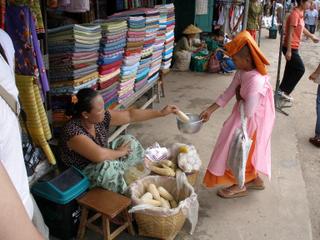
Today we traveled from Mengla to Kengtung (also known as Kiang Tong, and Chiang Tong). I have found that the Burmese here pronounce K and ‘Ch”. Thus the currency of Khiat is pronounced Chiat. I also learned a few more things about the Shan Special District No. 4. It is an autonomous region that has its own laws and military. The laws include legalized gaming and prostitution, which are illegal in the rest of Myanmar. People from Myanmar (including the rest of the Shan State, may freely enter Special District No. 4, but resident of the Special District need a pass to enter the rest of Myanmar.

Given the current political climate in Myanmar, I think that I should say a word or two about traveling to a country that most human-rights groups feels should be boycotted. This issue was a consideration in the early planning of the conference and the post-conference field trip. I asked sought the views of several people who I knew would be attending the conference about whether or not we should include Myanmar on a field trip itinerary because of the tourism boycott. None of them seemed to think it was a major issue.
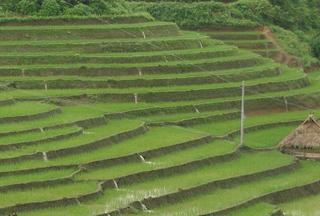
Keynote speaches were given in the early morning and paper sessions the later morning and afternoon today. A fairly long day, but with some interesting papers (including my own on “Tourism in the border lands of American Indian Country”). We did not have a closing banquet because we had done that on the first day when the president of Sun Yat-sen University was in town. He wants our next conference in two years to be in Guangzhou, to help give more international recognition to Zhongshan University, which is considered one of China's top universities. I am rooting for Xinjiang (Urumqi), though that would be expensive to get to. There are also a couple of other possible places.

One of the highlights of the conference that I help to organize here in China is the field trip. We generally do this in the middle of the conference, and it is often an all-day affair. This year, the original plan was to do two half-day trips to a Dai Village and to a border town. The border town, however, was closed to day trips by the Chinese government to stop Chinese nationals from going to Myanmar to gamble. So the new plan was to go to a tea plantation in the morning and to the Dai village in the afternoon. But when we woke up it was raining, making the road to the tea plantation unpassable. We would have been the first international tour group to visit this plantation. So, instead we went to the botanical gardens, which is a mass domestic tourist destination and has a very well done visitors interpretive center on the rainforest and local ethnic groups. It is one of the best that I have seen in China – where many interpretive centers only show oddly shaped rocks that look like birds and other objects, and discuss local folk mysteries as scientific facts.
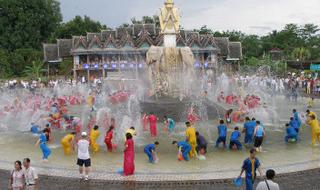
One thing I did the day before was to accompany several conference organizers to purchase shirts for the keynote speakers and myself. We went to a traditional Dai nationality dress shop and I got topic out my own preference in color design, which would then be made into a XXL size shirt (I wear a large in the US) in time for the opening sessions the next day. I had brought a coat and some ties for this event, but was happy to leave those in my suitcase!
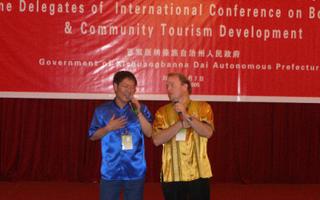
On the second day of our stay (July 6th – a day before the conference really started) several of us took a couple of taxis to the Mekong River. We walked over the bridge and made our way through town, invading and photographing a small morning market and a tea shop, among other interesting sights. The afternoon was hot and many just stayed in their rooms to get caught up on email (through a dialup connection offered by the hotel). In the evening we attended a cultural performance, which lasted from 8 pm to almost 11 pm! – It was very long, and consisted of a lot more comedy and audience-on-stage types of entertainment (an early form of reality entertainment!).

Conferencing is hard work! I have not had a chance since we arrived to really sit down and enter anything into this blog – there are just too many interesting and necessary thins to attend to.
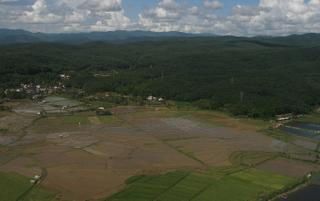
Every two years I help organize a tourism conference in China. My co-conspirators in China do most of the work. My role is to organize conference participants from outside of China. In the past we have had meeting in Guilin (2001) and at Three Gorges Dam/Yichang (2003) . This year (2005) the meeting will be in Xishuangbanna in Yunnan Province on July 6-9. Xishuangbanna is a county-level district and the actual conference is in the city of Jinghong, which is on the Mekong River near the border of China, Mynmar and Laos.